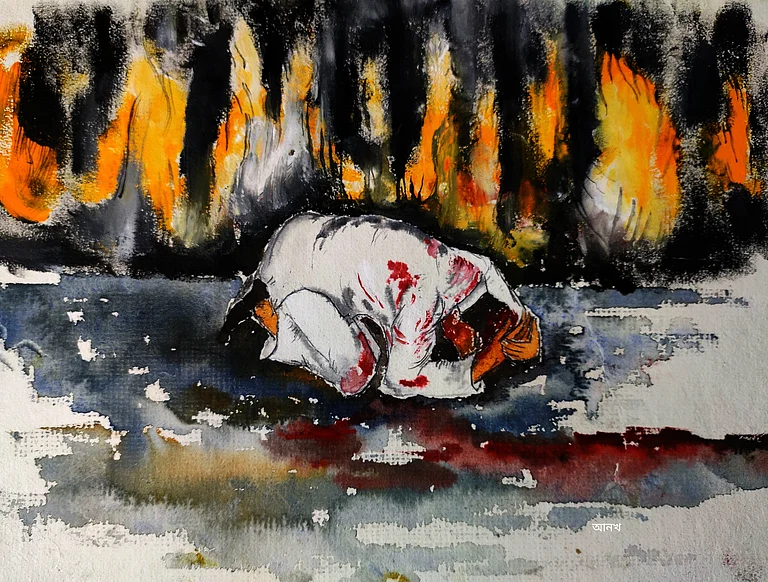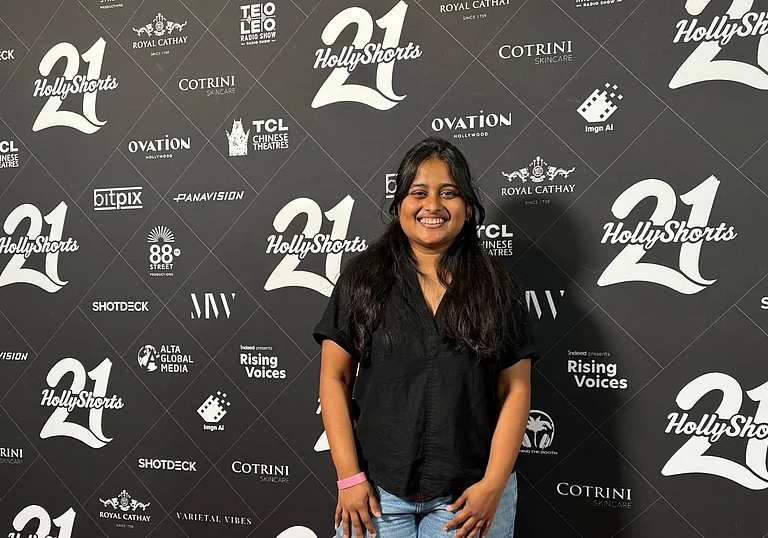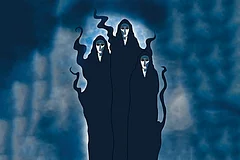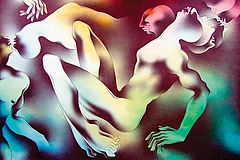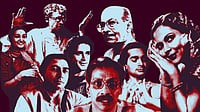Surrealist artist, author and provocateur Salvador Dalí finally made his way to India thanks to the curation by Christine Argillet, daughter of Pierre Argillet, Dalí’s publisher and lifelong friend. The exhibition ‘Dalí Comes to India’ , held from February 7 to 13 at the India Habitat Centre, New Delhi, showcased nearly 200 of his artworks from the Argillet Collection. At the venue, Argillet spoke to Apeksha Priyadarshini about her cherished memories of and experiences with her father’s favourite artist. Excerpts
How and why was Dalí fascinated with India?
Dalí was a very open-minded person. When he got married to Gala, in the late 20s, he went to eight different places of worship. He had this sense of universalism. In the mid-60s, he worked for Air India and made a fabulous ashtray with swans. When my father and I visited India in 1970, my father—an excellent photographer—returned from the tour with nearly 500 photos. Dalí said, “I’m very interested in India. I see a parallel between what westerners look for in their quest for the orient and what people of the orient seek in the West.”
He worked on some elements of destiny and fate, often representing yin yang and animals like cows, tigers and elephants. The elephants—common in Dalí’s works—are usually represented with very long legs and a ray that induces sleep or hypnosis. Dalí was interested in all kinds of spiritual quests—Buddhist, Hindu, Muslim. He saw all religions and their philosophies as a way to connect us and not separate us, which is very important in his work.

Can any Indian artistic influences be seen in his work?
I don’t know which Indian artist he met. But I see some connections, for instance, with Gulam Mohammed Sheikh, who is a fabulous artist, and who has a fantasy background, an original perspective that Dalí also looked at. There are many links, maybe much more than I know. And that’s the beauty with Dalí—you are always surprised. I keep discovering thing he did —furniture, jewelry, art, films, writings, beautiful novels that he wrote. He had very eclectic and diverse talents.
Could you tell us about his transition from Impressionism to Surrealism, while also dabbling in Dadaism and Cubism?
Dalí was extremely talented as a child. He was lucky to have a father who—even though he was not in the art field—loved art and would take him to exhibitions, etc. When he was 17, he had already exhibited with Picasso and Goya. But what pleased him in the Dada first, and then in the Surrealist movement, was the freedom of thought. In Europe, we were coming out of the First World War, where we saw many deaths, and people wanted to change things, break the frames, be very free. And he loved that idea. Surrealism and the link with the dream was what spoke to him the most. Surrealism started in 1924, with André Breton. Dalí took part in it. However, Breton was trying to frame Surrealism in certain ways, which were not corresponding to the movement. So, Dalí, in a very famous moment, went to one of the meetings wearing 20 different pullovers, one over the other. Each time Breton said something very straight, Dalí would remove one of the pullovers! He then removed all 20 and said, “The movement is not for me. I want to stay free!” Though he is one of the famous Surrealists, he separated from Breton, like many other artists did after these years. But it took them longer; Dalí became free very fast.

A lot of the artworks showcased in this collection feature women’s bodies. Did Dalí have any particular interest in portraying women?
Well, he was a man! His beautiful wife, Gala, was older than him and she died before him. She was an athletic, well-read and wonderful woman. Gala was his muse, but more than that, she took care of his material life. It’s her that we see in all those drawings—the different women are Gala in different situations. Especially in this period, Dalí has represented women in a beautiful way—powerful, equal to men, liberated. I’d say that this was not coming through in the works of all the Surrealists. The position Dalí took was quite stunning at his time.

Why is it that only etchings have been selected for this exhibition?
My father started as a journalist and a photographer and he loved the black and white works. One day, he went to these Surrealist artists and commissioned them for illustrations of novels, poems and so on. So, it started very much with the black and white and the etchings are part of that. Yet, many of these etchings here have been coloured afterwards with watercolours by Dalí. But the main idea was the graphic art. There are also watercolours here. What I wanted to show was the ‘Hippies’ series and the link to India.
Could you give us some insights into the relationship that your father shared with Dalí?
They had a very common way of seeing things. Not that my father was an artist; he was a great photographer, but he was not a painter. He had a love for art and they were sharing a lot of books, they were going to theatre together. All this was more friendship than the work of a publisher with the artist. It was sometimes fabulous, and sometimes, very difficult, because Dalí would request impossible things like, “Could you install a grand piano in an oak tree and have the pianist play while I paint?” And that could never be done! But there were also wonderful things which took place that would never have been thought before. Such was my father’s enthusiasm that he let the other artists slide to work only with Dalí in the 60s—the period that we show here.
What are your early memories of Dalí?
When I knew him particularly well, I was a child. Often, he would ask me, “Do you know how I can make my moustache move?” He would take some moustache cologne, add some herbs, and then apply it and put some scotch tape on it for a couple of hours. His moustache would stand then and he would move it. It was a lot of fun. One day, I told him, “You know, my mother always complains that she doesn’t dream.” I was eight years old, and he said to me, “You take this flower and put it on your mother’s night bed and see what she says.” I did it, without my mother knowing, and the next morning, she wakes up and says, “I haven’t dreamt for ten years and last night, I had a fabulous dream!” So I went to Dalí and said, “Yeah, it works very well!” It was a kind of grandfather-child like attitude, which was extremely kind and charming.
At the same time, I had the extraordinary chance to see him paint in his studio in Spain. On an easel, he always had a small canvas with geometric shapes and people would wonder what those shapes were for. Dalí would say, “Well, I always work on the golden ratio and I start my paintings with those lines and then I insert my work in it.” This was totally different from what we have here, which are sketches—spontaneous, springing from his mind immediately—while the paintings that we know quite well from the catalogues and exhibitions are mature, well-reflected works that took a long time to create. These works are more immediate; they relate to his direct impulse. For that reason, they are complementary.
How did your father chance upon meeting Dalí?
They met very early in the 30s at a congress in Amsterdam. My father was fascinated by the drawings of Dalí—his capacity to draw like the Italian Renaissance. They connected at that moment to do something together. But when the war happened, Dalí fled to New York for eight years. My father found him much later in the late fifties. It’s when he decided to work on the Greek mythology, which is presented here. It was not easy at the beginning, because when my father was not there to take the copper plates to print them, Dalí would sell them to somebody else. My father would be furious and would tell him, “Dalí, you cannot do that. We have a contract and you cannot sell what is prepared for our publication to somebody else.” But Dalí would say, “Oh! It doesn’t matter, I’ll do a better one for you!” My father was upset and he decided that all summers, we would go and spend July, August in Spain in a hotel in front of Dalí’s house. So, my father would get his plates immediately and have them ready for the publication. My father had so much pleasure working with Dalí that he left other Surrealists aside and worked extensively with Dalí. There are 200 different etchings, which stopped in 1973, when Dalí said that he didn’t want to etch anymore. To which, my father said, “Well, in that case, we stop the publication.” They went on to do different things from there.
Dalí’s political leanings have been contentious, especially within the history of the Surrealist movement. What are your thoughts on that?
Firstly, Dalí loved to shock the bourgeois. It was an immense pleasure for him. He wanted to generate a reaction from people. For instance, just before the Second World War, he made a painting, where you see an old telephone handle over a plate. In the plate, there is a small picture of Hitler. Dalí represents this telephone with a wire that is cut. It was 1937, and he didn’t see any possibility of dialogue with Hitler. Some people interpreted it as a fascination for Hitler. But it was not. He hated all that was violent. He hated the bullfights in his country. He hated the war. He hated Hitler. But the way he was saying it was not always understood. Dalí was not understood for what he was. But, he was also not aware of the bad or the good that he was doing sometimes.
If Dalí were alive today, would he find the contemporary state of the world surrealist?
I think that Dalí would have always been interested by science and technique, which he was in his time as well. He often had scientists coming to his place. He was always discussing with them and at his time, he worked on the DNA in many of his paintings. He was interested in holograms and worked on them at the end of his life. I’m sure he would have been very interested to see how we work virtually these days. He would have certainly tried NFTs and AI as tools to create something. He would have continued this process—which was a little Leonardesque—to be at the same time in sciences and art. Politically, he didn’t understand what was going on very well. But he had some main elements—he was extremely respectful of all cultures and religions. Most probably, he would have found a way to express his ideas.
MORE FROM THIS ISSUE
Dalí had a penchant for cinema. What drew him to the medium?
Very early on, when he was in Spain, he was a great friend of Luis Buñuel’s and they did two films together, which are probably more Dalínian than Buñuelesque. Later, when he was in the US, he worked with Alfred Hitchcock on Spellbound (1945). I think he was fascinated by the succession of the images and the rhythm that it implies. He also worked with Walt Disney for an animated film called Destino (2003), which has all the elements of Dalí’s paintings. He created more than 2000-3000 drawings to prepare this animated film and was passionate about it. He was always enthusiastic to do something new. The movement that you see in many of his works was something that spoke to him.
(This appeared in the Print as 'A signboard of Abstraction')









